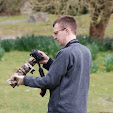Our last full day on Mull and, inspired by pictures like
these of White-tailed Eagles fishing off the back of boats on Mull, we emptied the piggy bank for a 3 hour trip today with Mull Charters on
Lady Jane. This was its first trip of the 2012 season, and with an excellent success rate in the last two years, hopes were high. A male Hen Harrier on the Torloisk road, and a female over the car park, seemed like good omens, as did a 2nd winter Iceland Gull which hung around the boat as we moored for tea and biscuits.
Although the skies were leaden, the inky waters of Loch na Keal and backdrop of the Gribun rocks made for a stunning setting, and with only 10 on the boat it was peaceful too. Auks and divers punctuated the journey, but after a couple of hours we were forced to concede that the White-tailed Eagles were not going to show. Particularly frustrating as the day before we had watched four circling over the area where the boat now sat! A distant view of a Golden Eagle was some consolation, but not what we had hoped for.
 |
| Great Northern Divers can be found in small flocks at this time of year - this group of six in a variety of plumages |
 |
| A GND starting the moult into summer plumage |
 |
| Another slightly further along the way |
 |
| This Red-throated Diver looked darker than a typical winter-plumaged bird, which would normally have more white on the face and neck - presumably a stage of moult. The upturned bill helps distinguish it from Black-throated. |
 |
| The same bird as above taking off - note the legs set at the back of the body. |
 |
| A more typical winter-plumaged Red-throated Diver |
 |
| Winter-plumage Guillemot |
 |
Summer plumage Razorbill |
 |
| Summer plumage Black Guillemot |
 |
| Black Guillemot in flight |
A pleasant cruise back to Ulva Ferry took us past some impressive basalt columns (made by the same geological process that produced nearby Staffa), a roost of Shag, a flotilla of Eider and some more divers. One with a pale bill merited a closer look given recent records of White-billed on Mull, but we had to conclude it was just a grey-billed Great Northern.
Although pleased with the Iceland Gull, there was inevitably some disappointment at not seeing the Eagles. Then, literally five minutes from the quay, an Otter surfaced just off the bows and showed superbly for the next five minutes - the only one we saw all week, and a real highlight not just for the boat trip but the whole holiday. It was almost as bold as the
Blandford otters which I saw in November, though the setting made this just a bit more special.






















































